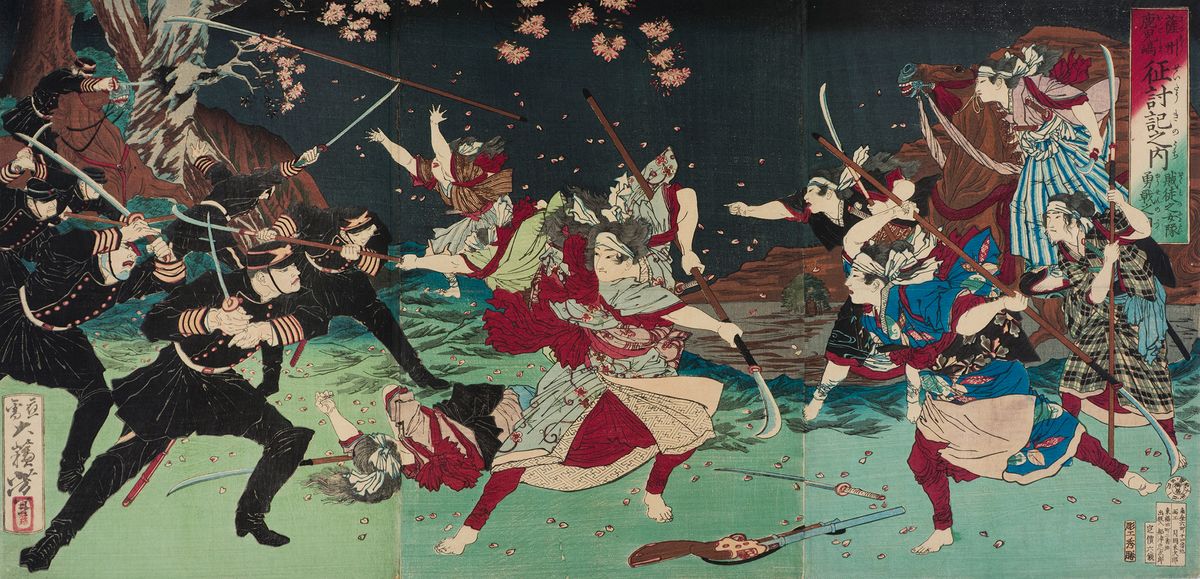In these spaces, wisdom is not just observed but experienced
The Japanese dry garden (枯山水, karesansui) or Japanese rock garden (also often called a Japanese Zen garden in the West) is a unique tradition that symbolizes minimalism, mindfulness, and tranquility.
This exceptional landscape art has evolved over centuries. Blending nature's beauty with deep philosophical insights. Each rock, plant, and ripple in the sand tells a story, inviting us to pause and reflect on the simplicity and depth of existence.
These gardens aren't just eye candy.
They're gateways to a deeper understanding of life's delicate balance and serenity. Offering moments of peaceful introspection. They connect us to a culture that celebrates the quiet, profound beauty of the world.
In this article, we’ll explore the history, types, and key features of Japanese Zen gardens and their role in Japanese culture. Then, we’ll also look at some famous Zen gardens in Japan and how to experience their magic.
What is the purpose of a Japanese Zen garden?
Japanese Zen gardens focus on simplicity, tranquility, and balance. Unlike typical gardens full of lush greenery, Zen gardens mainly use rocks, sand, gravel, and a few minimalistic plants. These elements are carefully arranged to help with meditation and reflection.
The gravel or sand is often raked into patterns to look like water ripples, symbolizing life's fluidity and impermanence. With their calm and harmonious layouts, Zen gardens create a peaceful environment perfect for contemplation and mindfulness. Reflecting the principles of Zen Buddhism.
The history and evolution of Zen gardens in Japan
The concept of Japanese Zen gardens is firmly rooted in the cultural history and philosophical thought of Japan. And the history of Zen gardens in Japan is a testament to their enduring appeal and relevance. From their humble beginnings in monastery grounds, these gardens have grown in popularity. Now, you can find them in various settings. Including private homes, temples, and public spaces.
But here's how it all started:
Heian period (794-1185)
Zen Buddhist monks created spaces to inspire contemplation and reflection. They believed immersing themselves in nature's simplicity and serenity led to deeper understanding of the world and themselves. That's how Japanese Zen gardens were born.
Over time, these gardens evolved. Influenced by the monks. Initially used for meditation, rock gardens are now integral to Japanese residential design.
Kamakura period (1185-1333)
The influence of Zen Buddhism kept shaping the development of Zen gardens. Principles like mindfulness and the pursuit of enlightenment became closely linked with their design and philosophy.
These gardens were viewed as a way to connect with nature and find inner harmony.
Muromachi period (1336-1573)
Zen gardens took artistic expression to new levels. Influenced by the wabi-sabi aesthetics, which embrace imperfection and transience, these gardens became even more minimalist and abstract.
The way rocks, sand, and gravel were arranged turned into a form of artistic composition. With each element thoughtfully placed to evoke a particular emotion or idea.
Edo period (1603-1868)
Rock gardens became more accessible to everyone. As Zen Buddhism gained popularity, so did the love for rock gardens.
Many daimyo (feudal lords) added rock gardens to their estates, spreading their presence throughout Japanese society.

What are elements of a Japanese Zen garden?
Traditional Japanese Zen gardens are usually pretty minimalist. Focusing more on what's left out than what's included. They're meant to inspire thoughts about the calm and deep mysteries of life. With fewer decorations, you can really appreciate the beauty of simplicity and find peace in the moment.
オアシスであれ。
Be an oasis.
– Zen proverb
Here are some key elements that make up a Japanese Zen garden:
- Rocks and stones: The most essential element in a Japanese Zen garden is, of course, the rocks. They are meticulously chosen and placed (while the placement isn't random) to create a sense of balance and harmony. Each rock has its own significance and purpose. Whether it's representing a mountain or symbolizing strength and stability.
- Sand and gravel: Japanese Zen gardens use sand and gravel to create patterns. Symbolizing water or waves. They also represent the flow of life and allow for meditative raking (a practice thought to promote mindfulness and focus). The act of raking can be seen as a metaphor for shaping our thoughts and finding inner balance.
- Plants and trees: Zen gardens are mostly known for their rocks and gravel. But adding a few carefully chosen plants can really enhance them. Minimalistic touches like bonsai trees or small patches of moss symbolize nature's resilience. And its ability to thrive even in tough conditions.
- Water features: In some Zen gardens, you'll find small ponds or streams that add a peaceful vibe and a soothing soundtrack. These elements also highlight the importance of water in Japanese culture. Symbolizing purity and life.
- Moss: Moss is a common element in Japanese Zen gardens. Representing age, tranquility, and endurance. It's often placed around rocks or at the base of trees to add texture and color contrast to the otherwise simple landscape. Its presence also adds to the garden's overall sense of natural harmony and balance.
- Gates and fences: Gates and fences often define a Zen garden's boundaries. Symbolizing the transition from the outside world to a tranquil space. Leaving distractions behind for mindfulness. These structures also enhance the garden's aesthetic with their clean lines and natural materials.
- Bridges and pathways: Bridges and pathways are used to guide visitors through the garden. Leading them on a journey towards inner peace and reflection. These structures also add depth and dimension to the landscape. Creating a sense of movement and flow.

The beauty of Japanese rock gardens lies in their simple yet lavish Zen aesthetic. They’re thoughtfully designed to create a peaceful and harmonious space that invites introspection and contemplation. Whether in a temple courtyard or a private backyard, these gardens remind us of the deep connection between humans and nature.
What is the philosophy of Japanese Zen gardens?
Japanese Zen gardens are not just about creating a serene and aesthetically pleasing space. They're also rooted in the principles of Zen Buddhism. And the design of these gardens reflects those principles. There are a few key concepts that guide the design and purpose of Japanese rock gardens:
- Harmony: Every element in a Zen garden is thoughtfully placed to create balance and harmony. Reflecting the importance of finding balance in life and achieving inner peace. (Interested in finding out how to achieve harmony?)
- Simplicity: In Japanese culture, simplicity is seen as a form of beauty. Zen gardens reflect this idea with their minimalist designs that highlight essential elements instead of flashy decorations.
- Emptiness: In Japanese, the concept of "mu," (無 – emptiness) is key to Zen philosophy. In rock gardens, this idea shows up as negative space. Creating a spot for contemplation and reflection. (By the way: In our article In the Eastern, emptiness is the key to living a fuller life, we explain how emptiness is not a lack of something in Eastern philosophy).
- Mindfulness: The act of creating and maintaining a Zen garden requires mindfulness and attention to detail. This practice promotes living in the present moment and letting go of distractions.
- Imperfection: Wabi-sabi aesthetics embrace the idea that imperfection is beautiful and fleeting. In Japanese Zen gardens, imperfections are embraced through elements like uneven gravel or asymmetrical placements.
Japanese rock gardens offer more than just a pretty view.
They offer a space for self-reflection and connection with nature. Their artful simplicity and deep philosophical roots make them a cherished aspect of Japanese culture and a source of inspiration for many around the world.

枯山水の庭を前に、少し落ち着こう。
In front of the dry landscape garden, let's feel a little sense of calmness.
– Zen proverb
The journey towards inner peace may be long and challenging, but with a little inspiration from Japanese Zen gardens, we can find moments of tranquility along the way.
So let's take a deep breath, rake some gravel, and embrace the beauty of simplicity in our own lives.
What are types of Japanese Zen gardens?
There are a few different types of Japanese Zen gardens, each with its own unique design and purpose.
Here are some of the most common types:
Karesansui (dry landscape) garden
This is probably the most well-known type of Zen garden. Consisting mainly of rocks and gravel with little to no plants. The "dry" part refers to the absence of water elements like ponds or streams.
Tsubo-niwa (courtyard) garden
These small, intimate gardens are often found in residential homes. They make use of limited space by incorporating various elements like rocks, gravel, plants, and water features into a confined area.
Tsukiyama (hill) garden
These gardens typically have a more naturalistic feel. Mimicking landscapes found in nature. They often include hills, trees, and water features to mimic mountains and valleys.
Chaniwa (tea garden)
These gardens are often found in traditional Japanese tea houses. They're designed to create a sense of peace and tranquility for tea ceremonies. Simplicity, harmony, and mindfulness are key elements in these gardens.
Strolling garden
These larger gardens were designed for leisurely walks and contemplation. They often feature a variety of elements like ponds, streams, bridges, and tea houses to create a diverse and immersive experience.

Visiting different types of Japanese Zen gardens can be a great way to explore the various styles and interpretations of these peaceful landscapes. And who knows – you may even find inspiration for your own garden along the way.
Japanese Zen gardens have even influenced cultures worldwide
The influence of Japanese Zen gardens extends beyond their borders. With many countries around the world incorporating elements of these gardens into their landscapes and architecture. Today, Japanese rock gardens continue to inspire designers, artists, and individuals seeking inner peace. Their philosophy of simplicity and mindfulness resonates with many people in our fast-paced modern world.
Influence on Western garden design
The timeless principles of Japanese Zen gardens have also greatly influenced Western garden design. Here are a few examples of their impact on Western gardening trends:
- Minimalism: Minimalism has become increasingly popular in Western culture. Inspired by Japanese Zen gardens, many modern designs feature simple, clean lines with essential elements. Choosing simpler and less busy designs. The "less is more" concept resonates deeply. Creating serene spaces that promote relaxation and reflection.
- Mindful living: With the rise of mindfulness practices and techniques, more people are looking for ways to include them in their daily lives. Japanese Zen gardens offer a physical space for practicing mindfulness and reflection.
- Garden rooms: Western designers have also picked up on the concept of creating "rooms" within a garden. Taking inspiration from the structured layout of Japanese gardens, these designs include distinct areas within one landscape, each providing a unique experience. This method lets the garden tell a story and encourages visitors to explore and reflect.
- Naturalistic landscapes: Lately, Western gardening has been moving towards more natural-looking landscapes. Taking cues from the organic and artful designs of Japanese rock gardens. People are opting for elements like stone, wood, and gravel for their natural beauty and harmony. This trend in Western designs leans towards sustainable, organic materials that help us connect with nature.
Overall, Japanese Zen gardens have inspired Western design to create peaceful, harmonious spaces that offer a break from everyday chaos. With their simplicity, natural materials, and thoughtful design, these gardens provide a sanctuary for reflection and inner peace.

Zen gardens in modern spaces
In today's busy and often chaotic world, the need for tranquility and peaceful retreats has really taken off.
That's why Zen gardens are popping up not just in traditional settings but also in the following ones:
Public parks: These days, many public parks have Japanese Zen gardens instead of the usual manicured lawns. These rock gardens offer a peaceful retreat for visitors, letting them connect with nature right in the middle of the city.
Wellness centers: Spas, retreat centers, and yoga studios are starting to add Japanese Zen gardens to their meditation spaces for a more peaceful experience. These spots offer a chance for reflection and meditation. Promoting mental wellness and well-being. The minimalist design and serene vibe make Japanese Zen gardens perfect for meditation, yoga, and other practices.
Urban Zen gardens: Gaining popularity among city dwellers seeking a quick escape from the hustle and bustle. These compact gardens feature artful rock arrangements, gravel, and minimalistic plant selections to evoke a sense of calm.
Home Zen gardens: Adding Zen garden elements to modern interior and exterior design is becoming a trend. Whether it's a balcony garden, a meditation room, or a backyard retreat, these spaces provide a place for reflection and mental wellness. Focused on simplicity, mindfulness, and natural beauty, they transform any area into a peaceful haven.
Corporate Zen gardens: Many companies are integrating Zen gardens into their wellness initiatives. These modern spaces offer quiet corners for employees to unwind and reset, promoting a mindful workplace culture. Features often include simple water elements, minimalistic pathways, and seating to encourage brief moments of meditation or reflection during the day.

By incorporating the core elements of traditional Japanese Zen gardens into modern settings, we can create spaces that bring balance and tranquility to our busy lives. Whether in a bustling city, a dynamic workplace, or a modern home, a Zen garden can remind us to pause, breathe, and appreciate the simplicity of the present moment.
How can I experience Japanese Zen gardens?
When visiting a Japanese Zen garden, it’s important to respect the space and its intended purpose of promoting peace and contemplation. These serene environments are designed to provide a retreat from the hustle and bustle of daily life. Encouraging mindfulness and reflection.
Here are some tips and etiquette to consider:
- Take a moment to pause and appreciate the intricate design and tranquility
- Use this time to meditate, reflect, or simply enjoy the peaceful surroundings
- Stick to the designated paths to preserve the delicate elements and keep the garden looking beautiful
- These gardens are meant for quiet reflection, so keep conversations low, walk softly, and avoid any disruptions
- Take photos discreetly without bothering anyone. Also, check if there are any restrictions on photographing certain areas.
- Approach the space with a calm and open mind. Engage with the garden’s elements through mindful observation and reflection.
- Don't touch or rearrange rocks, plants, or other features. Zen gardens are carefully designed, and changing anything can disrupt their harmony.

Seasonal changes and their beauty
Japanese Zen gardens are designed to reflect the changing seasons, each bringing its own unique beauty:
- Spring: Cherry blossoms and other spring flowers add vibrant colors and fragrant scents. This season symbolizes renewal and is a time for fresh beginnings.
- Summer: Lush greenery and the sound of flowing water create a cool oasis. The garden feels alive with the full bloom of plants and the play of sunlight and shade.
- Autumn: Brilliant foliage in shades of red, orange, and yellow transform the garden into a fiery display. Autumn symbolizes harvest and reflection.
- Winter: Snow and frost create stark, serene landscapes. The simplicity and minimalism of the garden’s design are highlighted. Offering a sense of stillness and peace.

Mindfulness and meditation practices
Japanese Zen gardens offer ideal settings for practicing mindfulness and meditation.
Here are a few ways you can incorporate these practices:
- Journaling: Bring a notebook and pen to the garden and spend a few minutes writing down your thoughts, feelings, or any insights gained during your meditation or mindfulness practice.
- Visual meditation: Sit quietly and take a good look at something specific in the garden, like a rock arrangement or a water feature. Just let your mind zone in on that one thing and let other thoughts drift away.
- Sound meditation: Listen to the natural sounds of the garden, such as rustling leaves, flowing water, or bird songs. Let these sounds center your thoughts and bring a sense of peace.
- Walking meditation: Slowly walk through the garden, paying attention to each step, the sounds around you, and your breath. Focus on being fully present in the moment.
- Breathing exercises: Sit in a comfortable spot within the garden and practice deep, slow breathing. Concentrate on the flow of your breath to promote relaxation and reduce stress.
- Contemplative observation: Spend time observing the various elements of the garden, such as the patterns in the sand, the flow of water, or the arrangement of rocks. Reflect on their symbolism and the sense of tranquility they evoke.

By appreciating the seasonal changes and practicing mindfulness and meditation, you can fully experience the tranquility and beauty of Japanese Zen gardens.
6 famous Zen gardens in Japan
Visiting a Japanese Zen garden in person is an experience that lingers long after you leave.
Picture the neatly arranged rocks, the carefully trimmed trees, and the calming water features that together create a scene of tranquility. As you stroll through the garden, each step invites you to reflect and find inner peace. You can't help but admire the artistry and philosophy in every element. Feeling a deep connection to a tradition of harmony and mindfulness that has lasted for centuries.
This journey through the Zen garden is not just a visit but a moment of intimate discovery and cultural appreciation.
Here are some of the most famous rock gardens in Japan:
- Daitoku-ji Temple Complex (Kyoto): Comprised of 22 sub-temples, each with its own unique Zen garden, this complex is a must-see for any spiritual seeker or garden enthusiast.
- Adachi Museum of Art (Shimane): With a focus on incorporating nature into its design, this garden is considered one of the best gardens in Japan.
- Kenroku-en Garden (Kanazawa): This garden is known as one of the three great gardens in Japan and features stunning views of seasonal landscapes.
- Katsura Imperial Villa (Kyoto): Known for its exquisite garden design, this villa offers a glimpse into traditional Japanese aesthetics and architecture.
- Tofuku-ji Temple (Kyoto): The famous rock garden here is a prime example of Zen minimalism and has inspired many other gardens in Japan.
- Ryoan-ji Temple (Kyoto): This iconic temple is home to one of the most famous Zen gardens in the world. With its 15 carefully positioned rocks representing a mother tiger and her cubs crossing a river.
Here's an interactive map (and route) highlighting the locations of all the Zen gardens:
Japanese Zen gardens are an aesthetic blend of art and philosophy
Zen gardens are more than mere visual spectacles.
They embody a profound philosophy. Encouraging harmony, tranquility, and a deep connection with nature. These meticulously designed sanctuaries, with their serene atmospheres, stand as a testament to Zen principles: simplicity, balance, and mindfulness. By immersing yourself in these tranquil spaces, you are invited to slow down, reflect, and find clarity amid the chaos of daily life.
In Zen gardens, you cultivate a personal bond with nature by appreciating its beauty and fleeting moments. As the seasons change, so do the gardens. Reminding us of life's inherent impermanence.
This relationship encourages us to be present. To savor fleeting moments. And to cultivate gratitude for the natural world.
Whether through a contemplative walk, a meditative gaze upon a meticulously arranged rock, or simply sitting in silence, Zen gardens offer a sanctuary where you can reconnect with the essence of nature and, in turn, with yourself.
In these spaces, wisdom is not just observed but experienced.
Imparting valuable lessons in simplicity, patience, and the enduring beauty of our natural surroundings.
P.S. Here's a video I found that beautifully captures the essence of Japanese Zen gardens:
25 moss and Wabi Sabi gardens in Kyoto by Harukawa Film Works






